Top Links
Journal of Gynecology Research
ISSN: 2454-3284
Anti-GnRH Receptor Monoclonal Antibodies, First-In-Class GnRH Analog
Copyright: © 2015 Lee G. This is an open-access article distributed under the terms of the Creative Commons Attribution License, which permits unrestricted use, distribution, and reproduction in any medium, provided the original author and source are credited.
Related article at Pubmed, Google Scholar
A monoclonal antibody (Mab) designated as GHR106 was generated against the extracellular domain (N1-29 synthetic peptide) of human gonadotropin releasing hormone (GnRH) receptor. It is a first-in-class GnRH analog and can serve as a drug candidate for potential applications in the treatment of human cancers and/or fertility regulations. Both Mabs in murine (mGHR106) or humanized (hGHR106) forms were shown to have comparable specificity and affinity to intact GnRH receptor on cancer cells or to N1-29 synthetic peptides from humans and monkeys. Similar to decapeptide GnRH analogs, both Mabs were shown to induce apoptosis to cultured cancer cells of various tissue origins, including those from the ovary, breast, prostate, and lung. However, both Mabs were also found to induce complement-dependent cytotoxicity (CDC) reaction for lysis of cancer cells, an immune property which is not shared by peptide analogs of GnRH. By using semi-quantitative reverse transcription polymerase chain reaction (RT-PCR), both GHR106 Mabs and the GnRH decapeptide antagonist, Antide, were shown to be bioequivalent in terms of their respective effects on genes involved in the proliferation and apoptosis of cancer cells. In addition, GHR106 Mabs have a much longer circulating half-life than GnRH peptide analogs (days versus hours). Based on the results of these studies, it can be concluded that both mGHR106 and hGHR106 are bioequivalent to the GnRH decapeptide antagonist, Antide, in many biological and functional properties. Therefore, hGHR106 can serve as a long-acting alternative to the current decapeptide GnRH antagonists for therapeutic treatments in the immunotherapy of human cancers, including those of gynecologic origin.
Keywords: Monoclonal antibodies; GnRH Receptor; Bioequivalent GnRH analogs; GHR106
Abbreviations: ADCC: Antibody-dependent cellular cytotoxicity; ALP: Alkaline phosphatase; ATCC: American Type Culture Collection; CDC: Complement-dependent cytotoxicity; cDNA: Complementary deoxyribonucleic acid; CDR: Complementarity determining region of immunoglobulin; c-fos: Cellular proto-oncogene; CRO: Contract research service; Cyclin D1: G1/S phase regulator protein; EGF: Epidermal growth factor; Fab: Fragment antigen-binding region of immunoglobulin; Fc: Fragment crystallizable region of immunoglobulin; FR: Framework region of immunoglobulin; GADPH: Glycerdaldehyde-3-phosphate dehydrogenase; GnRH: Gonadotropin-releasing hormone; hGHR106: Humanized form of GHR106; IgG: Immunoglobulin G; IHC: Immunohistochemistry; IVF: In vitro fertilization; Kd: Dissociation constant; KLH: Keyhole limpet hemocyanin; Mab: Monoclonal antibody; mGHR106: Murine form of GHR106; nHIgG: Normal human IgG; nMIgG: Normal mouse IgG; Po, P1, P2, L37: Ribosomal proteins for protein synthesis; P21: Cyclin-dependent kinase inhibitor 1; PCR: Polymerase chain reaction; POD: Peroxidase; RPMI 1640: Roswell Park Memorial Institute medium; RNA: Ribonucleic acid; RT-PCR: Reverse transcription polymerase chain reaction; TUNEL: Terminal deoxynucleotidyl transferase dUTP nick end labeling
Gonadotropin releasing hormone (GnRH), both types I and II, is a decapeptide hormone that stimulates the release of gonadotropin, luteinizing hormone (LH) and follicle stimulating hormone (FSH) from the anterior pituitary through specific binding to the GnRH receptor located on the external membrane of selected cell types [1-3]. Subsequent studies revealed that GnRH and its receptor also play extra-pituitary roles in numerous normal and malignant cells or tissues, the mechanisms of which are still being actively explored [4-6]. Anti-proliferation effects of GnRH or its analogs on cancer cells of different human tissue origins have been reported and have been the molecular basis for cancer therapy [4,7-9].
Numerous clinical studies have also reported the use of cytotoxic GnRH analogs or GnRH analogs alone as anti-cancer drugs [10]. To improve efficacy, GnRH analogs are sometimes formulated by covalently linking cytotoxic anti-cancer agents, such as AN-152 or AN-207, to GnRH or its analogs. GnRH agonists or antagonists have been reported to suppress cancer cell growth clinically [11]. GnRH analogs, such as Leuprorelin, Buserelin, and Goserelin, have been used in the treatment of hormone-responsive cancers, such as prostate and breast cancers [11]. However, limited and variable efficacy was observed in many cases. Nevertheless, this approach has been shown to be effective in cancer treatments with a lower toxicity and improved efficacy when compared to non-targeted systemic chemotherapy [11]. GnRH analogs have also been used for the treatment of other estrogen-dependent conditions, such as endometriosis, uterine fibroids, and endometrial thinning, to treat precocious puberty, and to control ovarian stimulation in in vitro fertilization (IVF) [11].
While it has been established that GnRH and its analogs exhibit anti-proliferative effects on cancer cells or tissues, the efficacy of GnRH and its analogs is limited by their relatively short half-life in circulation. For example, GnRH has a half-life of only 2-4 minutes, while decapeptide GnRH analogs have half-lives of a few hours [12-14]. Therefore, the use of GnRH or its analogs as drugs generally requires frequent administration. There remains a need for the development of alternate approaches for the treatment of these conditions by using agents which have improved half-lives, efficacy, and/or tolerability.
The development of antibody-based anti-cancer drugs as an alternative to traditional agents in human cancer treatments has been explored in recent years. It is important that the drug target on the cancer cell surface be clearly identified, expressed with high abundance, and its mechanisms of action be well elucidated [15].
Monoclonal antibodies generally have a relatively long half-life in human circulation, typically ranging from 5 to 22 days. Thus, the use of monoclonal antibodies as drugs provides an attractive alternative for the treatment of cancer, and antibodies targeting the GnRH receptor provides a major advantage over the decapeptide GnRH analogs due to a much longer half-life in circulation (e.g., from 5 to 22 days versus hours for the peptidic GnRH analogs). In particular, monoclonal antibodies to the GnRH receptor may be useful for the treatment of hormone-sensitive cancers, such as prostate and breast cancers, and for the regulation of fertility. Such antibodies may also reduce potential side effects [10,11].
A monoclonal antibody against a synthetic peptide corresponding to amino acid residues 1-29 in the N-terminal extracellular domain of the human GnRH receptor has been reported to bind to human breast and ovarian cancer cell lines [16]. A monoclonal antibody against a synthetic peptide corresponding to amino acid residues 5-17 in the N-terminal extracellular domain of the mouse hypophyseal GnRH receptor has been reported to react with a human ovarian cancer cell line and to inhibit endometrial maturation in mice [14,16-21].
The generation of anti-GnRH receptor antibodies for the diagnosis and treatment of reproductive disorders and for contraception has been extensively studied [16-18]. The generation of antibodies to the type II receptor for contraception have also been reported. It also has been suggested that the use of anti-GnRH receptor antibodies among many other entities in combination with a growth regulating factor may be utilized for the treatment of cancer [11].
In this mini-review, we would like to summarize preclinical evaluations of a monoclonal antibody designated as GHR106, which was generated against the N1-29 synthetic peptide corresponding to the extracellular domain of the human GnRH receptor. mGHR106 was subsequently humanized (hGHR106) and evaluated through numerous biochemical and immunological studies [22]. The main objective of this study would be to determine if hGHR106 is substantially bioequivalent to mGHR106 and can serve as the alternative to decapeptide GnRH analogs in treating human cancer, as well as for other gynecologic indications [11].
All the chemicals and reagents used in this chapter were obtained from Sigma Chemicals Co. (St Louis, Missouri USA) unless otherwise specified.
All cancer cell lines employed in this report including those of the prostate (DU-145, PC-3), lung (A549) and breast (MDAMB-435) were from American Type Culture Collection (ATCC) (Rockville, MD), except OC-3-VGH. OC-3-VGH is an ovarian cancer cell line established in 1986 by the Department of Obstetrics & Gynecology at the Veterans General Hospital, Taipei, Taiwan [23]. This cancer cell line is of serous origin and can be cultured or maintained in Roswell Park Memorial Institute medium (RPMI 1640 medium) containing 10% bovine serum and penicillin-streptomycin. Other cell lines were cultured and maintained according to instructions provided by ATCC.
Oligopeptides corresponding to the N-terminal amino acid residues (N1-29, N182-193, N195-206, and N292-306) in the extracellular domains of the human GnRH receptor (from Gemed Lab, South San Francisco, CA and Genscript, Piscataway, NJ) and conjugated separately to keyhole limpet hemocyanin (KLH) by standard methods [16,24]. They were used separately as immunogens to generate monoclonal antibodies of high affinity and specificity [16,25,26]. Only the N1-29 synthetic peptide was sufficiently immunogenic to generate monoclonal antibodies. One of the monoclonal antibodies, GHR106, was selected for further studies and sequence determinations were performed in the variable regions of this monoclonal antibody [27]. Microwells coated with N1-29 synthetic peptide or OC-3-VGH ovarian cancer cells were employed to estimate affinity and determine specificity between GHR106 and the GnRH receptor, as well as the corresponding N1-29 synthetic peptides from mice and monkeys.
Apoptosis assays: To investigate the anti-proliferative or apoptotic effect of GnRH peptide analogs and GHR106 Mabs on a variety of cultured cancer cells, an In Situ Cell Death Detection Kit, Peroxidase (POD) (Roche, Canada) was employed for detection and quantitation of apoptosis at cellular levels [28]. Briefly, the cancer cell lines were cultured in RPMI 1640 medium at 37 °C in a CO2 (5%) incubator for 24 hours until all cancer cells became attached to the micro-wells. The GnRH decapeptide antagonist, Antide, (0.1μg/mL) and GHR106 Mabs of known concentrations (2-10μg/mL) were added separately for co-incubation for 24 hours and/or 48 hours. For the negative control, normal mouse IgG of identical concentration (10μg/mL) was used under the same incubation periods. At the end of the incubation, attached cells were removed from the tissue culture wells. Apoptosis of treated cancer cells was determined quantitatively by terminal deoxynucleotidyl transferase dUTP nick end labeling (TUNEL) assay according to manufacturer's protocol [28].
Complement-dependent cytotoxicity (CDC) assay: Complement-dependent cytotoxicity (CDC) assay was performed as described previously [19]. Briefly, 1×105 cultured cancer cells in 1mL of appropriate culture medium (RPMI 1640 with 10% fetal calf serum) were plated in 24-well plates for 2 hours before treatment. The GnRH decapeptide antagonist, Antide, and GHR106 Mabs were added separately to give a final concentration of 10μg/mL and incubated for 15min at room temperature. Three microliters of freshly prepared rabbit baby complement (CL3441, Cedarlane Labs; Burlington, NC USA) was added to each well followed by incubation at 37 °C for 2 hours. After incubation at room temperature, the cells were recovered by centrifugation. Trypan blue (0.4%; SV30084.01; Thermo Scientific, Waltham, MA, USA) was added and mixed gently. The percentages of cells stained with Trypan blue were determined by cell counting under a regular microscope. Normal mouse IgG of the same concentration was used as the negative control. Incubation with the antibody or the complement alone served as the respective negative controls for parallel comparisons in this experiment. Statistical analysis was performed to determine the significance of the assay by the Trypan blue method [29].
Total RNA extraction, cDNA synthesis, and semi-quantitative PCR: Total RNA was extracted from different cell lines (105-107 cells) using QIAGEN RNeasy mini kit. RNase-free DNase set was included to avoid genomic gene interference. Reverse transcription (RT) of total RNA (0.5–5 μg/20 μL) to cDNA was performed by using oligo (dT)15 primers and EasyScript™ First Strand cDNA Synthesis kit from Applied Biological Materials Inc. (Richmond, BC, Canada), following the manufacturer's instructions. Reaction mixtures with the RNA template but without reverse transcriptase (or with reverse transcriptase but without the RNA template) were used as the negative controls for cDNA synthesis.
All primers required for polymerase chain reaction (PCR) amplifications are derived from human tissues and were obtained from Integrated DNA Technologies (San Diego, CA USA). They have been described in a previous publication [20]. Primers utilized are listed as followed:
GnRH-I: 5'-AACCTCTTCACCTTCTGCTGCCT-3' (sense) and 5'-GATTTCTT CCCAGACCCTCTTACGAG-3' (antisense); GnRH receptor: 5'-TGACACGGGTCCTTCATCAG-3' (sense) and 5'-AAGTGGATCAAAGCATGGGTTT-3' (antisense); ribosomal protein P0: 5'-TTGTGTTCACCAAGGAGG-3' (sense) and 5'-GTAGCCAA TCTGCAGACAG-3' (antisense); ribosomal protein P1: 5'-CAAGGTGCTCGGTCCTTC-3' (sense) and 5'-GAACATGTTATAAAAGAGG-3' (antisense); ribosomal protein P2: 5'-TCCGCCGCAGACGCCGC-3' (sense) and 5'-TGCAGGGGAGCAGGAATT-3' (antisense); epidermal growth factor (EGF): 5'-AAGGAAA TCCTCGATGAAGCCT-3' (sense) and 5'-TGTCTTTGTGTTCCCGGACATA-3' (antisense); cellular protooncogene (c-fos): 5'-GAGATTGCCAACCTGCTGAA-3' (sense) and 5'-AGACG AAGGAAGACGTGTAA-3' (antisense) [20]; cyclindependent kinase inhibitor 1 (P21): 5'-GCAGACCAGCATGACAGATTT-3' (sense) and 5'-GGATTAGGGCTTCCTCTTGGA-3' (antisense) [30]; G1/S phase regulator protein (cyclin D1): 5'-GTCTCAAAGCTTGCCAGGAG-3' (sense) and 5'-ATATCCCGCACGTCTGTAGG-3' (antisense) [31].
A housekeeping gene, glyceraldehyde-3-phosphate dehydrogenase (GAPDH) was amplified to check the functional integrity of cDNA and used as the internal control by using 5'-GAAATCCCATCACCATCTTCC-3' (sense) and 5'-CCAGGGGTCTTACTCCTTGG-3' (antisense) as primers [32].
PCR was performed by using 2× PCR Plus MasterMix kit (Applied Biological Materials Inc., Richmond, BC, Canada) according to the manufacturer's instructions. After denaturing at 94 °C for 4min, 20-35 cycles were performed under the following conditions: denaturing at 94 °C for 40s, annealing at 58 °C for 60s and extension at 72 °C for 1min. A final complete extension was then executed at 72 °C for 7min. At the end, the PCR product was checked by 1.5% agarose gel electrophoresis. The relative signal intensities of different PCR products on the agarose gel were semi-quantitatively analyzed by ImageQuant image analysis software [33]. The intensity of negative control was adjusted to 100% in each case for comparative purposes.
Immunohistochemical assays: Immunohistochemical (IHC) staining experiments were performed by using the avidin/biotin complex (ABC) method from Vector Laboratories (Burlingame, CA, USA) for cells from four different cancer cell lines including C33A (cervix), PC-3 (prostate), OVCAR-3 (ovary), and MDA-MB-435 (breast). For IHC studies of OC-3-VGH ovarian cancer cells, as well as paraffin-embedded cancerous tissue sections, alkaline phosphatase (ALP)-labeled secondary antibodies (BioRad, Hercules, CA USA), including goat anti-mouse IgG-ALP and goat anti-human IgG-ALP, were used. Prior to IHC, de-paraffinization and methanol fixations were performed. The cancerous human tissue sections were incubated in 0.1M phosphate buffered saline containing 10% goat serum and 1% Triton X-100 for 1 hour. These sections were then incubated with 5μg/mL primary antibody (mGHR106 and hGHR106) for 2 hours at 37 oC. Normal mouse IgG or normal human IgG were used in parallel as the negative control. The incubation with labeled secondary antibodies (at 100 to 1000ng/mL), as well as color staining, was performed at room temperature for 1 hour by following the protocols and instructions provided by the ALP detection kits (Biorad, Richmond, CA). Counter staining was performed with haemotoxylin. The cancerous human tissue sections were obtained from the Shanghai Institute of Biological Sciences in Shanghai, China, as well as the Beijing University Medical College in Beijing, China.
Statistical analysis: All experiments were performed in triplicate. All the results presented as mean ± SD. Student's T-test was performed to estimate the statistical significance.
Based on the results of these binding assays, the dissociation constant (Kd) between GHR106 and GnRH receptor, or the corresponding N1-29 synthetic peptide was estimated to be 2 x 10-9M [34]. Through contract research service (CRO) by LakePharma Inc., mGHR106 was humanized to hGHR106. hGHR106 was shown to have an affinity constant which was similar to that of the original mGHR106 to the GnRH receptor on well-bound cancer cells [27].
To determine the relative specificity of mGHR106 and hGHR106 to the GnRH receptor on immobilized cancer cells, binding inhibition studies were performed. Results are presented in Table 1A and 1B respectively. In Table 1A, the percent inhibition of dose-dependent binding of hGHR106 to well-coated OC-3-VGH ovarian cancer cells was determined in the presence of 1μg/mL N1-29 synthetic peptides of the GnRH receptor from human (Hu), monkey (Mo), and mouse (Mu), respectively. Similarly, in Table 1B, percent inhibition of dose-dependent binding of mGHR106 to well-coated cancer cells was estimated and presented for the co-incubation of hGHR106 and N1-29 synthetic peptides from three different species, including that of the human (Hu), monkey (Mo), and mouse (Mu). Based on the results of this binding study, it can be concluded that both hGHR106 and synthetic peptides derived from humans and monkeys showed significant dose-dependent inhibition to mGHR106 binding to the GnRH receptor, whereas the mouse-derived peptide revealed little or no inhibition (Table 1A and 1B) [25].
The IHC studies were performed with fixed cells of the OC-3-VGH ovarian cancer cell line, as well as cancerous tissue sections, by using mGHR106 or hGHR106 Mabs as the comparative probe. Both were found to be equivalent in the staining patterns as presented in Figure 1A with fixed OC-3-VGH ovarian cancer cells. With mGHR106 as the probe, positive staining of ovarian cancer tissue sections was observed when compared with that of the negative control with normal mouse immunoglobulin alone. Results are presented in Figure 1B.
A 40-65% increase in apoptosis of treated cancer cells was found upon 24 to 48 hrs incubation with either 2-10μg/mL GHR106 Mabs, mGHR106 or hGHR106, or 0.1μg/mL of the GnRH decapeptide antagonist, Antide (Figure 2A). Other cancer cell lines which were tested included the PC-3 (prostate), DU-145 (prostate), A549 (lung), and MDA-MB-435 (breast) cancer cell lines (Figure 2B) [17,19]. When mGHR106 and hGHR106 were compared for efficacy in inducing apoptosis, they were found to be equally effective in inducing apoptosis to cultured cancer cells, as demonstrated in data presented as histograms in Figure 2A [17].
Specific binding interactions between cancer cell surface bound GnRH receptor and anti-GnRH receptor Mabs, such as mGHR106 or hGHR106, can result in cell lysis in the presence of complement [16,17,19]. Therefore, by CDC assays, both mGHR106 and hGHR106 at 10μg/mL were shown to induce complement-dependent cytotoxicity to a similar and significant extent. Results are depicted in Figure 2C.
As the negative control, normal mouse and normal human IgG were utilized, and found to have little effect on complementdependent cell lysis. In addition, use of GnRH or its analogs, such as the GnRH decapeptide antagonist, Antide, revealed little to no effect on complement-dependent cytotoxicity, indicating the absence of CDC reactions in the presence of Antide and complement.
Upon treatments of cultured cancer cells with the GnRH decapeptide antagonist, Antide, or GHR106 Mab, expression of genes involved in cell proliferation or survival were found to be changed significantly. The levels of gene regulation changes estimated by semi-quantitative RT-PCR are presented in Table 2 for comparisons between Antide and mGHR106 Mab.
Interestingly, Antide and mGHR106 Mab were found to have identical patterns of gene regulations to the treated cancer cells. While the GnRH gene was found to be upregulated upon ligand treatments, the expression of the GnRH receptor was unchanged. The EGF gene was found to be downregulated by either ligand, as was cyclin D1, a cell cycle regulator [27]. Therefore, the observed gene regulation changes were consistent with the molecular mechanisms of action of these two GnRH receptor ligands in inducing apoptosis to the treated cancer cells [35-38]. However, information is limited regarding the molecular of actions of these two receptor ligands on the pituitary gland. Further preclinical and clinical studies may be required to resolve this question.
The experimental data summarized in this review clearly demonstrate the biosimilarity between the GnRH decapeptide antagonist, Antide, and anti-GnRH receptor Mabs, either in the murine or humanized forms of GHR106. Despite dramatic differences in molecular size between peptide analogs and Mabs (15 kDa vs. 80 kDa), both peptide analogs and Mabs exhibit similar functional and biological activities to the GnRH receptor on the cancer cell surface. However, GHR106 Mabs have a much longer circulating half-life and are capable of inducing cell lysis through CDC reactions. This type of complement-dependent cytotoxicity mechanism is unique for antibodies only, and not for GnRH peptide analogs [19].
IHC staining studies revealed that GHR106 reacts with cells from many different cancer cell lines, as reported previously [18-20]. The IHC staining of ovarian cancerous tissue was found to be consistent with that of the anti-GnRH receptor antibody obtained from commercials sources [37]. The present study also confirmed that tissue sections of four different human cancers, including those of the liver, ovary, breast, and colon, to also be positively stained by GHR106, indicating the surface expression of the GnRH receptor in these cancerous tissues [27].
Biosimilarity between mGHR106 and the GnRH decapeptide antagonist, Antide, was further demonstrated by gene regulation studies [27]. Upon treatment of cancer cells with Antide, the gene regulation or expression patterns were found to be virtually identical to those by GHR106, suggesting similar mechanisms of action by both ligands to the GnRH receptor on cancer cells [27]. Based on the results of our analysis, both GHR106 and Antide were found to affect the expressions of an identical set of genes involved in cell proliferation, protein synthesis, and cell cycle regulations, such as P0, P1, and P2, c-fos, cyclin D1, and EGF (Table 2). These results strongly suggest the bioequivalent biological functions of GnRH peptide analogs and GHR106 to the human GnRH receptor expressed on the cancer cell surface [16,17,19].
The longer circulating half-life for GHR106 may be beneficial in cancer treatment, compared to GnRH peptide analogs which are currently utilized clinically as anti-cancer drugs [10,34,36,39]. The unique advantage of GHR106 Mabs over peptide analogs may be better demonstrated during clinical trials. Furthermore, CDC and antibody-dependent cellular cytotoxicity (ADCC) reactions are unique for antibody drugs, such as GHR106 Mab in cancer therapy. In comparison, GnRH peptide analogs do not possess similar effector functions [19].
Murine GHR106 was humanized through contract research organization services from LakePharma Inc. (Belmont, CA). Briefly, the amino acid sequence in the Fab regions of both the heavy and light chains for mGHR106 were converted into humanized form (hGHR106) through the use of special software programs for humanization. While preserving the affinity and specificity of GHR106 to the human GnRH receptor, various substitutions in the amino acid sequences of the Fab regions of both the heavy and light chains were required. They were further classified into FR and CDR domains in either the heavy or light chains to facilitate comparisons between mGHR106 and hGHR106. In the FR domains of the Fab regions, the homology in the amino acid sequence was decreased to 80% and 85% for the heavy and light chains, respectively, between mGHR106 and hGHR106. In contrast, 100% homology in the corresponding CDR domains was maintained for the preservation of affinity and specificity of hGHR106 to the human GnRH receptor. Overall, the homology between mGHR106 and hGHR106 in the Fab regions was decreased to 93% and 89% for the heavy and light chains, respectively [22].
As described in previous sections, for comparative biochemical and immunological studies between mGHR106 and hGHR106, both were shown to have similar dissociation constants to the GnRH receptor on cancer cells, which is in the order of 1 x 10-9 M (1-5nM). Therefore, the bioequivalence between mGHR106 and hGHR106 have been clearly demonstrated through this humanization strategy [22]. Through binding inhibition studies, both hGHR106 and human or monkey derived N1-29 synthetic peptides of the GnRH receptor demonst rated significant dose-dependent inhibition to mGHR106 binding to the GnRH receptor, whereas mouse derived peptide revealed little to no inhibition. This differential inhibition can be explained based on the sequence homology of N1-29 peptides from these different species. Between monkeys and humans there are only two amino acid substitutions whereas there are as many as six amino acid substitutions between humans and mice [25,27,40]. Therefore, mGHR106 and hGHR106 may cross-react with those of the monkey species. This information may be useful when performing future clinical investigations when the monkey is used as the animal model [27].
Humanizations of GHR106 have become an essential process during the research and development of antibody-based drugs, mainly due to intrinsic species differences in the immunogenicity of antibodies. Therefore, preclinical and clinical studies with humanized Mab may be the final proof to demonstrate the efficacy of hGHR106 in anti-cancer therapy, despite the fact that the slow-release long-acting GnRH peptide analogs or small organic molecules are also currently available for clinical studies [4,5,8,10,11,22,34,38,39].
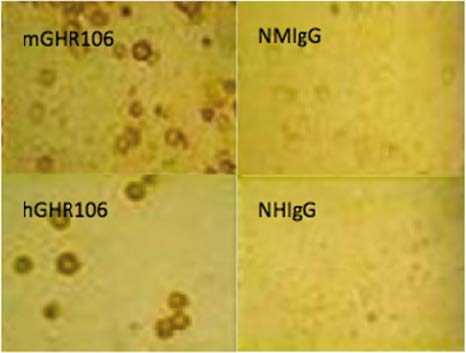 |
| Figure 1A: IHC staining of cancer cells with anti-GnRH receptor monoclonal antibodies. (A) IHC staining of OC-3-VGH ovarian cancer cells with mGHR106) and hGHR106 are shown on the left. Negative IHC staining with normal mouse IgG (nMIgG) and normal human IgG (nHIgG) are shown on the right. |
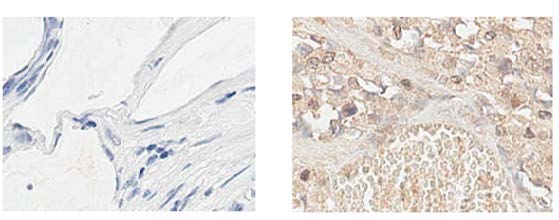 |
| Figure 1B: IHC staining of ovarian cancer tissues sections with normal mouse IgG (left) and mGHR106 (right), respectively. |
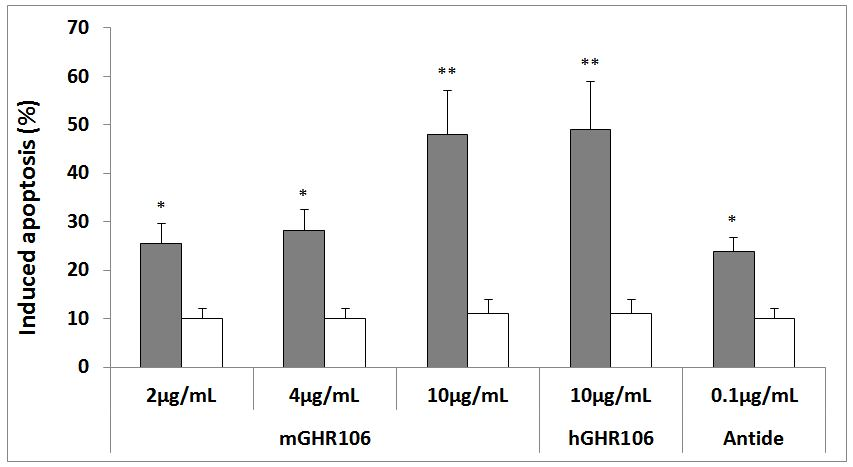 |
| Figure 2A: Experiments to reveal induced apoptosis and cell lysis by complement-dependent cytotoxicity (CDC) reactions. (A) Effects of GnRH decapeptide antagonist, Antide, and anti-GnRH receptor Mabs, mGHR106 and hGHR106, on induced apoptosis to OC-3-VGH ovarian cancer cells by TUNEL assay after 48 hours incubation. Data are presented in histograms and listed as followed ( ■ ) in the x-axis: 2μg/mL, 4μg/mL, and 10μg/mL mGHR106, 10μg/mL hGHR106, and 0.1μg/mL Antide. (☐) represents the negative control with either 10μg/mL normal mouse IgG or 10μg/mL human IgG for each corresponding set of experiments. * and ** indicate statistical significance of P < 0.05 and P < 0.01, respectively. |
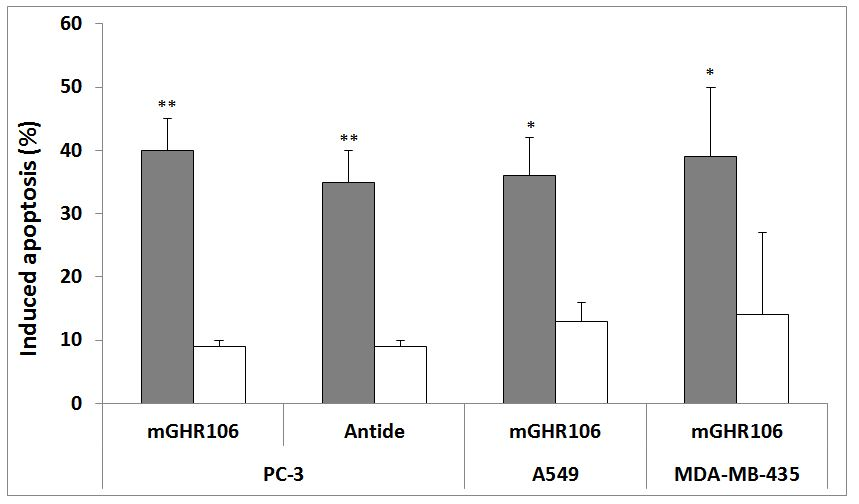 |
| Figure 2B: Effects of GnRH decapeptide antagonist, Antide, and anti-GnRH receptor Mab, mGHR106, on induced apoptosis to different cultured cancer cells by TUNEL assay after 48 hours incubation. Data are presented in histograms and listed as followed ( ■ ) in the x-axis: mGHR106 (10μg/mL) and Antide (0.1μg/mL) with PC-3 prostate cancer cells; mGHR106 (10μg/mL) with A549 lung cancer cells; mGHR106 (10μg/mL) with MDA-MB-435 breast cancer cells. (☐) represents the negative control with either 10μg/mL normal mouse IgG or 10μg/mL human IgG for each corresponding set of experiments. * and ** indicate statistical significance of P < 0.05 and P < 0.01, respectively. |
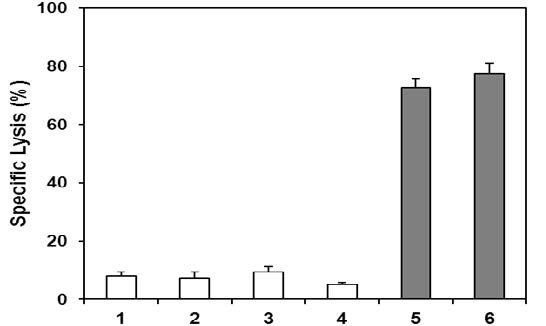 |
| Figure 2C: Lanes 1 to 4 represent negative controls. Lane 1: no treatment (negative control); Lane 2: 3 μL freshly prepared rabbit baby complement (negative control); Lane 3: normal human IgG (10 μg/ml plus complement) (negative control); Lane 4: normal mouse IgG (10 μg/mL plus complement) (negative control); Lane 5: hGHR106 (10 μg/ml plus complement) (2 hour incubation); Lane 6: mGHR106 (10 μg/ml plus complement) (2 hour incubation). ** indicate statistical significance of P < 0.01. |
| Percent inhibitiona,b(%) | |||
|---|---|---|---|
| hGHR106 (μg/mL) | Hu-P | Mo-P | Mu-P |
| 0.25 | 17 | 50 | 28 |
| 0.125 | 50 | 37 | 0 |
| aHu-P: N1-29 synthetic peptide of human GnRH receptor; Mo-P: N1-29 synthetic peptide of monkey GnRH receptor; Mu-P: N1-29 synthetic peptide of mouse GnRH receptor bduplicate assays with errors of ±20% Table 1A: Enzyme immunobinding assay to reveal percent inhibition of hGHR106 binding to well-coated OC-3-VGH ovarian cancer cells in the presence of 1μg/mL GnRH-receptor synthetic peptides from human (Hu-P), monkey (Mo-P), and mouse (Mu-P), respectively. |
|||
| Percent inhibitiona,b(%) | ||||
|---|---|---|---|---|
| mGHR106 (μg/mL) | hGHR106 | Hu-P | Mo-P | Mu-P |
| 0.50 | 31.4 | 35.2 | 43.6 | 0 |
| 0.25 | 63.1 | 59.2 | 55.3 | 5.3 |
| aHu-P: N1-29 synthetic peptide of human GnRH receptor; Mo-P: N1-29 synthetic peptide of monkey GnRH receptor; Mu-P: N1-29 synthetic peptide of mouse GnRH receptor bduplicate assays with errors of ±15-20% Table 1B: Enzyme immunobinding assay to demonstrate percent inhibition of humanized GHR106 (hGHR106) binding to well-coated OC-3-VGH ovarian cancer cells in the presence of 1μg/mL murine (mGHR106), and GnRHreceptor synthetic peptides from human, monkey, and mouse, respectively. |
||||
| Gene | Relative gene expression levelsa | |
|---|---|---|
| mGHR106 (10 or 20μg/mL)b | Antide (GnRH decapeptide antagonist) (0.1 μg/mL) | |
| GnRH | Up (60% ± 10%) | Up (45% ± 15%) |
| GnRH receptor | NC | NC |
| P0 | Down | Down |
| P1 | UP | UP |
| P2 | NC | NC |
| L37 | Down | Down |
| EGF | Down | Down |
| c-fos | NC | NC |
| P21 | Up | Up |
| Cyclin D1 | Down | Down |
| aFollowing ligand incubation with cancer cells, relative expression level changes: up means increase by 20% or more (unless otherwise indicated), down means decrease by 20% or more, or no change (less than 20% increase or decrease) (NC), with either 10μg/mL or 20μg/mL mGHR106 incubation, or 0.1 μg/mL Antide, are shown. The GAPDH gene was used as the internal reference. bChanges in gene regulation do not vary significantly with either 10 or 20μg/mL mGHR106 treatment of cancer cells Table 2: Effects of GnRH decapeptide antagonist, Antide, and mGHR106 Mab on the expression level changes of genes involved in cell proliferation, protein synthesis, and cell cycle regulations of cultured OC-3-VGH ovarian cancer cells |
||






































